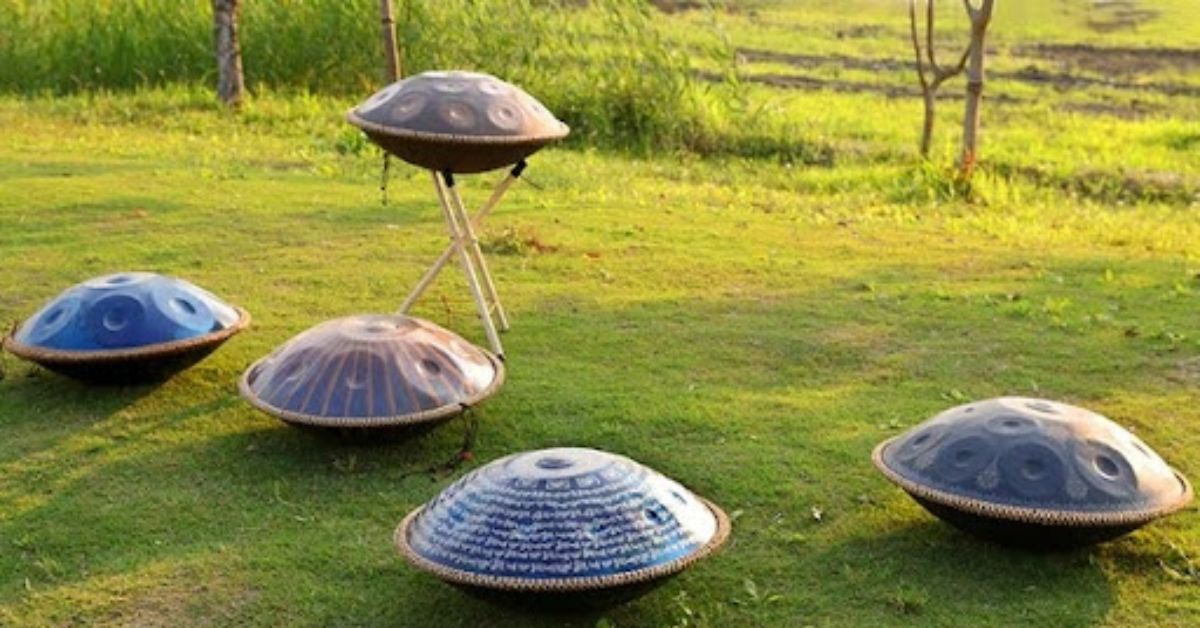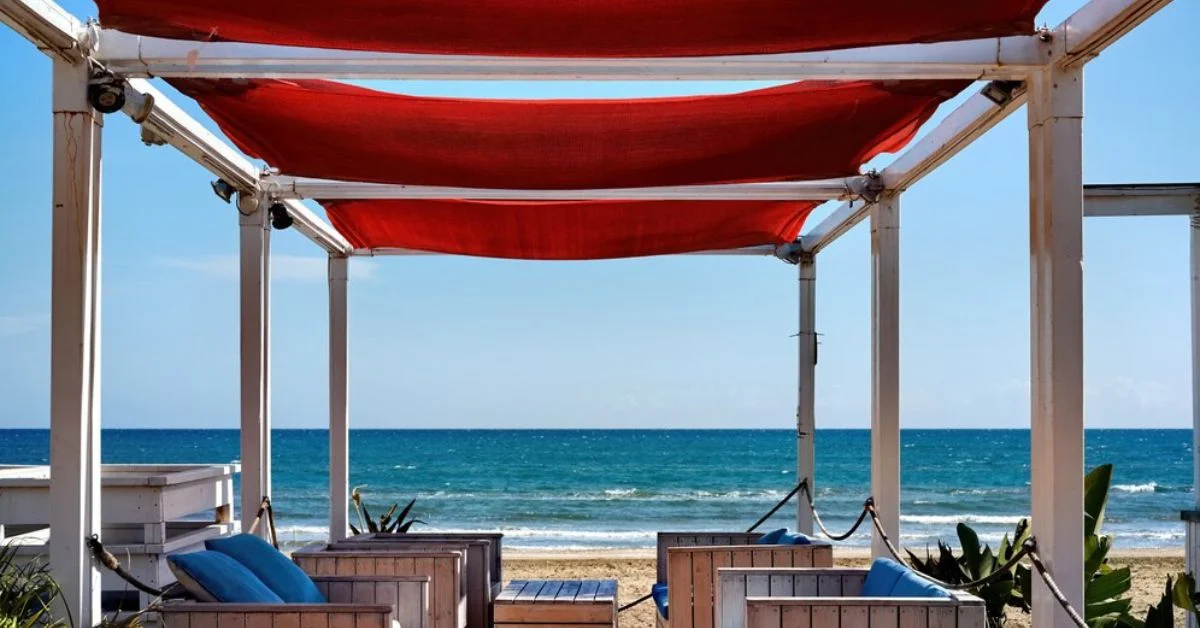GENERAL
How To Compose Your Own Handpan Songs From Scratch

Are you someone with a deep love for music and relaxing sounds? Creating your own melodies has become so much fun and easier with handpan drums. If you’ve fallen for its melodious music, you being a newbie won’t matter. Even if you’re just starting out or have been playing the hang for some time, composing your own music can become one of the most exciting and satisfying experiences ever. In this article, you can learn all about how you can create your songs and enter the world of peaceful and mesmerizing music, right from your heart!
Step 1: Get To Know Your Handpan
Before you jump into the groove and start composing songs, it’s best to take some time to explore the hang drum’s sound. Different types of handpans are tuned to a certain scale, with each note harmonizing beautifully with the others. What you can do is play every note slowly and get yourself familiar with all of the tones, noticing the way they resonate with each other.
You can also listen for natural patterns since you’ll notice that some notes naturally feel like they belong together. Another great technique is to experiment with rhythms by tapping lightly, then with some more force to see how the dynamics change. Consider this step an official “meeting” with your hang instrument. The more you play, the more you’ll understand its unique voice.
Something else that you can do here is try closing your eyes while you play to completely draw your focus on the sound and vibration. It’ll help deepen your connection with the instrument and help you notice nuances that usually go unnoticed. Make sure to play in different environments, like in a quiet room, outside in nature, or with some gentle background noise in the atmosphere.
Step 2: Start With Simple Patterns
Once you’ve become familiar with your instrument, it’s time to look for a starting point for your song. Begin by playing a couple of notes and observe the ones that sound good together. Make sure not to overthink it and let your fingers move naturally on your handpan. Repeat the shorter sequences and tweak them just a bit until you finally find something that sounds good to you.
One great way for you to find a pattern is to set a timer for five minutes and improvise from there. It’s completely okay if you keep making mistakes, just continue playing. Once the timer stops, go back to listen to what you’ve played and choose the parts that you like the most. This helps keep the process exciting and spontaneous, keeping you hooked on song composition.
Step 3: Expand On Your Idea
Once you get your hands on a basic pattern, it can be expanded by changing the rhythm, i.e., playing the same notes slowly and then increasing the speed. Connect different sections smoothly by adding nearby notes. You can introduce depth into the mix by playing some notes softly and the others with intensity. You can always go back and play it again if you feel stuck.
Multiple handpan players also utilize looping pedals to construct layers. However, even without one, you can continue repeating your phrase and explore smaller variations. You can also try reversing the order of the notes by introducing an additional beat or changing the way you strike them. Making those small tweaks can make a massive difference in your journey.
One other useful tip is to experiment with various time groupings, so instead of always playing in sets of four beats, you can try to use five or seven beats for a unique rhythm. Feel free to also switch the order in which you hit the notes because there are many times when only moving your hands differently can completely change the entire feel of your overall melody.
It’s important to remember that taking breaks is also a part of the process, and an essential one at that. You can step away for a while, then come back with fresh ears since this can help you hear your composition in a whole new way. It’s also a good practice to listen to other handpan players or different styles of music to get some inspiration. Anything can spark a new idea!
Step 4: Experiment With Dynamics & Emotion
Good music isn’t all about the notes, it’s actually about how you play them. Make sure to play some notes gently for a calm and relaxing feel, then from here on, you can try more powerful strikes for excitement and energy. Silence is equally as essential as sound, so utilize pauses to the fullest in order to create and bring some emotion and anticipation into the process.
You should also try breathing in rhythm with your handpan playing, so inhale as you lightly tap and exhale once you play with more intensity. This link between breath and music makes the entire handpan playing experience feel a whole lot more natural and expressive.
Step 5: Structure Your Song
You can now shape your ideas and patterns into a complete song. Here’s a simple structure you can follow:
1. Intro – Begin with soft, slow notes to set the mood.
2. Main Theme – Clearly play your core melody.
3. Variation – Change the rhythm or add extra notes.
4. Climax – Build excitement by playing faster or louder.
5. Outro – Slow down, go back to the main theme, and fade out.
This structure helps make your song feel more complete, but you don’t have to exactly follow it. If another format fits your playstyle, then you can go with it. The most important thing is that your composition flows naturally and feels satisfying to you when you play.
Step 6: Record & Reflect
When you play through your entire song a couple of times, make sure to record yourself. Once you listen back, it helps you hear what’s working for you and highlights the areas where you can improve things. Don’t aim for perfection because music is a whole journey. Therefore, your song will naturally evolve the more you play it.
You can record several takes and layer them together with the help of simple recording apps. It’ll help you hear your song’s different angles and enhance the parts you might not have noticed while you were playing the instrument.
Conclusion
Creating your own Cosmos handpan song is among some of the most satisfying and rewarding experiences you can have with this instrument. It doesn’t have to be that complex, you can just start with a simple idea, build around it, and let your emotions pave the way. So, grab your handpan, start playing, and allow the music to flow through you in this song-making journey!
GENERAL
The Charm of Singing Waiters for Memorable Wedding Celebrations

Singing waiters for weddings infuse your special day with an unparalleled charm, elevating the ambiance to pure magic. These exceptional performers seamlessly blend into the catering staff, surprising and delighting guests with their extraordinary vocal talents. Let’s delve into the enchanting world of singing waiters and discover why they’re the ultimate addition to your wedding celebration.
Experience the Elegance of Live Entertainment
Imagine the awe on your guests’ faces as they are serenaded by professional singers disguised as waiters. This unique form of live entertainment adds a touch of sophistication and class to your wedding festivities. From romantic ballads to upbeat tunes, singing waiters effortlessly set the mood, creating memorable moments that will be cherished for years to come.
Create Memorable Moments with Surprise Performances
One of the most delightful aspects of singing waiters is the element of surprise they bring to your event. Guests are taken aback when their servers suddenly burst into song, turning an ordinary dining experience into an extraordinary performance. Whether it’s during cocktail hour, dinner service, or dessert, these talented singers know exactly when to captivate your audience with their stellar vocals.
Personalize Your Playlist for a Bespoke Experience
With singing waiters, you have the flexibility to customize your musical repertoire to suit your taste and preferences. Whether you’re a fan of classic love songs, contemporary hits, or Broadway show tunes, you can curate a playlist that reflects your unique style as a couple. From the first dance to the grand finale, every song is carefully selected to enhance the romance and joy of your special day.
Enhance the Atmosphere with Professional Talent
Unlike traditional wedding entertainment, singing waiters offer a dynamic and interactive experience that engages guests on a deeper level. With their professional training and stage presence, these performers know how to command attention and create a vibrant atmosphere that keeps everyone entertained. Whether they’re serenading the newlyweds or encouraging guests to join in on the fun, singings waiters bring an energy and excitement that is simply irresistible.
Leave a Lasting Impression on Your Guests
Your wedding day is a reflection of your love story, and every detail should be thoughtfully curated to leave a lasting impression on your guests. By incorporating singing waiters into your celebration, you’re not only adding a unique and memorable touch, but you’re also creating an experience that will be talked about long after the last dance. From the heartfelt performances to the joyous reactions of your loved ones, singings waiters ensure that your wedding is truly unforgettable.
Conclusion
Singing waiters for weddings offer a magical blend of live entertainment, surprise performances, and personalized charm that elevate your special day to new heights. With their exceptional talent and dynamic presence, these performers create unforgettable moments that will be cherished by you and your guests for a lifetime. So why settle for the ordinary when you can experience the extraordinary? Make your wedding truly unforgettable with the enchanting allure of singings waiters.
FAQs
What exactly are singing waiters?
Singings waiters are professional performers who disguise themselves as waitstaff at weddings and other events. They seamlessly blend into the catering team and surprise guests with unexpected vocal performances throughout the event.
How do singing waiters enhance the wedding experience?
Singings waiters add a unique and memorable element to weddings by providing live entertainment that is both surprising and delightful. Their performances elevate the atmosphere, creating magical moments that guests will always remember.
Can I choose the songs for the singing waiters to perform?
Yes, one of the advantages of hiring singings waiters is the ability to personalize the playlist to suit your preferences. Whether you prefer romantic ballads, upbeat tunes, or a mix of genres, you can work with the performers to create a bespoke musical experience for your wedding.
When and where do singing waiters typically perform during the wedding?
Singing waiters can perform at various points throughout the wedding, including during cocktail hour, dinner service, or dessert. Their performances are strategically timed to surprise and entertain guests at key moments during the celebration.
How do I ensure a seamless integration of singing waiters into my wedding plans?
To ensure a seamless integration of singings waiters into your wedding plans, it’s essential to communicate with your event planner or catering coordinator. Provide them with the necessary information about the performers and discuss any specific requests or preferences you may have regarding their performance schedule and repertoire. This will help ensure that the singings waiters complement your wedding vision and enhance the overall guest experience.
GENERAL
Covered Comfort: Crafting Custom Awning Manufacturing for Your Outdoor Oasis

Introduction to Awning Manufacturing
Awning manufacturer is a meticulous process that involves crafting protective coverings for windows, doors, patios, and outdoor spaces. These structures not only offer shade and protection from the elements but also enhance the aesthetic appeal of buildings and outdoor areas. In this article, we’ll delve into the world of awning manufacturing, exploring the various types, materials used, the manufacturing process, benefits, challenges, and future trends.
Types of Awnings
Retractable Awnings
Retractable awnings are versatile structures that can be extended or retracted as needed. They are ideal for both residential and commercial settings, offering flexibility and convenience.
Fixed Awnings
Fixed awnings are permanently attached to a building or structure, providing continuous protection from sun, rain, and other weather conditions. They are popular for their durability and stability.
Freestanding Awnings
Freestanding awnings are standalone structures that can be placed anywhere in outdoor spaces such as gardens, patios, or poolside areas. They offer shade and shelter without the need for attachment to a building.
Materials Used in Awning Manufacturing
Awnings are crafted from a variety of materials, each offering unique properties and benefits.
Fabric
Fabric awnings are commonly made from materials such as canvas, acrylic, or polyester. These fabrics are durable, weather-resistant, and come in a wide range of colors and patterns to suit different preferences.
Metal
Metal awnings, typically made from aluminum or steel, are known for their strength and longevity. They are highly resistant to corrosion and can withstand harsh weather conditions.
Plastic
Plastic awnings, often constructed from materials like PVC or polycarbonate, are lightweight and easy to maintain. They are also available in various styles and colors, making them a popular choice for modern designs.
The Process of Awning Manufacturing
The manufacturing process of awnings involves several stages, from designing to installation.
Designing
The first step in awning manufacturing is designing. This involves creating detailed plans and specifications based on the client’s requirements and the intended use of the awning.
Fabrication
Once the design is finalized, the fabrication process begins. This includes cutting, sewing, and assembling the various components of the awning, such as the frame, fabric, and hardware.
Installation
The final stage is the installation of the awning. This requires careful positioning and mounting to ensure proper functionality and stability.
Key Considerations in Awning Manufacturing
When manufacturing awnings, several factors need to be taken into account to ensure quality and customer satisfaction.
Durability
Durability is crucial for awnings to withstand exposure to sun, wind, rain, and other environmental factors. High-quality materials and construction techniques are essential for long-lasting performance.
Aesthetic Appeal
Awnings play a significant role in enhancing the visual appeal of buildings and outdoor spaces. Choosing the right design, fabric, and color can greatly contribute to the overall aesthetic of a property.
Functionality
Functionality is another important consideration in awning manufacturing. Awnings should be easy to operate, provide adequate shade and protection, and complement the architectural style of the building.
Benefits of Choosing a Reputable Awning Manufacturer
Opting for a reputable awning manufacturer offers several advantages, including:
- High-quality craftsmanship
- Customization options
- Professional installation services
- Warranty coverage and after-sales support
Factors to Consider When Choosing an Awning Manufacturer
When selecting an awning manufacturer, it’s essential to consider the following factors:
Experience
Choose a manufacturer with extensive experience in the industry and a proven track record of delivering quality products and services.
Reputation
Research the manufacturer’s reputation by reading customer reviews, testimonials, and checking their credentials and certifications.
Customer Service
Excellent customer service is crucial for a positive experience. Look for manufacturers who prioritize customer satisfaction and offer responsive support throughout the purchasing process.
Trends in Awning Manufacturing
As technology and design trends evolve, so do awning manufacturing techniques. Some emerging trends in the industry include:
- Motorized awnings with remote control functionality
- Smart awnings equipped with sensors for automatic operation
- Sustainable materials and eco-friendly designs
Sustainability in Awning Manufacturing
With growing concerns about environmental conservation, sustainability has become a key focus in awning manufacturing.
Eco-friendly Materials
Many manufacturers are transitioning to eco-friendly materials such as recycled fabrics, sustainable woods, and low-impact production processes to reduce their environmental footprint.
Energy Efficiency
Energy-efficient awnings, designed to minimize heat gain and reduce cooling costs, are gaining popularity among environmentally conscious consumers.
Challenges Faced by Awning Manufacturers
Despite the benefits and advancements in awning manufacturing, manufacturers face several challenges, including:
- Intense competition in the market
- Rising material and labor costs
- Meeting changing regulatory requirements and standards
The Future of Awning Manufacturing
The future of awning manufacturing looks promising, with continued innovation and advancements in technology, design, and sustainability.
Conclusion
Awning manufacturing is a dynamic industry that plays a vital role in enhancing the functionality and aesthetics of residential and commercial properties. By understanding the different types, materials, processes, and considerations involved, consumers can make informed decisions when choosing awnings for their spaces.
FAQs
How long does it take to manufacture an awning?
- The manufacturing timeline can vary depending on factors such as the complexity of the design, availability of materials, and the manufacturer’s workload. On average, it may take anywhere from a few days to a few weeks to complete the manufacturing process.
Can awnings be customized to fit specific dimensions?
- Yes, most awning manufacturers offer customization options to tailor the size, shape, and design of the awning to the client’s specifications.
What maintenance is required for awnings?
- Regular maintenance, such as cleaning the fabric and inspecting the hardware for any signs of wear or damage, is recommended to prolong the lifespan of awnings. Specific maintenance requirements may vary depending on the type of awning and its exposure to environmental elements.
Are awnings suitable for all weather conditions?
- While awnings provide protection from sun, rain, and mild wind, they may not be suitable for extreme weather conditions such as hurricanes or heavy snowfall. It’s essential to consider the climate and location when installing awnings and to take appropriate precautions to ensure their durability and safety.
Can awning fabric be replaced if damaged?
- Yes, in most cases, awning fabric can be replaced if it becomes damaged or worn out over time. Many manufacturers offer replacement fabric options, allowing customers to refresh the appearance of their awnings without replacing the entire structure.
GENERAL
The Versatility of Retractable Structures: Enhancing Spaces with Flexibility

Retractable structures have revolutionized the way we design and utilize spaces, offering flexibility, and functionality like never before. From retractable roofs to movable walls, these innovative architectural elements have become increasingly popular across various industries. In this article, we delve into the world of retractable structures, exploring their history, benefits, applications, and future trends.
History of Retractable Structures
Retractable structures have a rich history dating back centuries. One of the earliest examples dates back to ancient Roman times, where amphitheaters were equipped with retractable awnings to provide shade during events. Over the years, advancements in technology and engineering have led to the development of more sophisticated retractable systems.
Types of Retractable Structures
Retractable Roofs
Retractable roofs are perhaps the most common type of retractable structure, commonly found in sports stadiums and outdoor venues. These roofs can open and close, allowing for natural ventilation and exposure to the elements when desired.
Retractable Walls
Retractable walls offer the flexibility to transform indoor spaces seamlessly. Whether it’s dividing a large area into smaller sections or opening up a room to the outdoors, retractable walls provide versatility in design and functionality.
Retractable Floors
Retractable floors, although less common, are gaining popularity in residential and commercial settings. These floors can be raised or lowered to create multi-functional spaces, such as swimming pools that can be covered and converted into dance floors or event spaces.
Benefits of Retractable Structures
Flexibility and Versatility
One of the primary benefits of retractable structures is their ability to adapt to changing needs and environments. Whether it’s accommodating different weather conditions or transitioning between indoor and outdoor spaces, retractables structures offer unmatched flexibility.
Energy Efficiency
Retractable structures can enhance energy efficiency by maximizing natural light and ventilation. By opening up spaces to the outdoors, buildings can reduce reliance on artificial lighting and HVAC systems, leading to potential cost savings and environmental benefits.
Enhanced Aesthetics
In addition to their functional benefits, retractable structures can enhance the aesthetics of a space. Whether it’s showcasing architectural design or creating a unique ambiance, retractable elements add visual interest and sophistication to any environment.
Applications of Retractable Structures
Sports Venues
Retractable roofs have become a staple feature in modern sports stadiums, allowing events to take place rain or shine. These roofs provide spectators with a comfortable viewing experience while maintaining the integrity of the game.
Residential Spaces
In residential settings, retractable structures offer homeowners the opportunity to maximize outdoor living spaces. Whether it’s creating a seamless transition between indoor and outdoor areas or providing shade and protection from the elements, retractables structures add value and functionality to homes.
Commercial Buildings
From restaurants and cafes to retail stores and event venues, retractables structures are transforming the way commercial spaces are designed and utilized. These structures enable businesses to create dynamic and inviting environments that cater to diverse needs and preferences.
Considerations When Implementing Retractable Structures
While retractable structures offer numerous benefits, there are several factors to consider when implementing them:
Cost
The cost of installing and maintaining retractables structures can vary depending on factors such as size, materials, and complexity. It’s essential to weigh the upfront investment against the long-term benefits and consider the potential return on investment.
Maintenance
Retractables structures require regular maintenance to ensure optimal performance and longevity. This may include inspections, lubrication, and repairs as needed. Proper maintenance can help prevent costly issues and prolong the life of the structure.
Durability
Durability is another crucial factor to consider when choosing retractables structures. High-quality materials and construction methods are essential to withstand exposure to the elements and frequent operation. Investing in durable materials and professional installation can help ensure the longevity and reliability of the structure.
Future Trends in Retractable Structures
As technology continues to advance, we can expect to see exciting innovations in retractable structures. From enhanced automation and remote control capabilities to sustainable materials and energy-efficient design, the future of retractables structures is bright and promising.
Conclusion
Retractable structures have transformed the way we design and experience spaces, offering unparalleled flexibility, functionality, and aesthetic appeal. Whether it’s creating dynamic sports venues, versatile residential spaces, or innovative commercial buildings, retractables structures continue to push the boundaries of architectural design and engineering.
FAQs
1. Are retractable structures suitable for all climates?
Retractables structures can be designed to withstand various weather conditions, making them suitable for a wide range of climates. However, factors such as wind, snow, and extreme temperatures may affect their performance and durability.
2. Can retractables structures be retrofitted into existing buildings?
Yes, retractables structures can often be retrofitted into existing buildings with careful planning and design. However, the feasibility of retrofitting will depend on factors such as structural integrity, space availability, and budget constraints.
3. How long do retractables structures typically last?
The lifespan of retractables structures can vary depending on factors such as materials, usage, and maintenance. With proper care and maintenance, high-quality retractables structures can last for decades.
4. Are retractables structures energy-efficient?
Retractables structures can enhance energy efficiency by maximizing natural light and ventilation. By reducing reliance on artificial lighting and HVAC systems, retractables structures can help lower energy consumption and operating costs.
5. Can retractable structures be customized to fit specific design requirements?
Yes, retractables structures can be customized to fit specific design requirements, including size, shape, and functionality. Whether it’s creating a unique architectural feature or maximizing space utilization, retractables structures offer endless possibilities for customization.

 TECHNOLOGY4 months ago
TECHNOLOGY4 months agoBlog Arcy Art: Where Architecture Meets Art

 ENTERTAINMENT1 week ago
ENTERTAINMENT1 week agoExploring the Kristen Archives: A Treasure Trove of Erotica and More

 ENTERTAINMENT4 days ago
ENTERTAINMENT4 days agoKiss KH: The Streaming Platform Redefining Digital Engagement and Cultural Currents

 LIFESTYLE4 months ago
LIFESTYLE4 months agoThe Disciplinary Wives Club: Spanking for Love, Not Punishment

 LIFESTYLE1 week ago
LIFESTYLE1 week agoWho Is Sandra Orlow?

 GENERAL4 months ago
GENERAL4 months agoWhat are stories of male chastity? A Comprehensive Guide

 EDUCATION4 days ago
EDUCATION4 days agoLingrohub Platform: A Complete Student Access Guide

 ENTERTAINMENT4 weeks ago
ENTERTAINMENT4 weeks agoMonkeyGG2: Your Personal Gaming Hub










